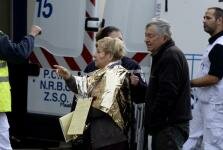
Photo Illustration by Sarah Rogers/The Daily Beast
Russia’s two-month-old military intervention in Syria on behalf of the embattled regime of Syrian president Bashar al-Assad has involved dramatic, and highly visible, strikes by high-tech jet fighters, lumbering heavy bombers, powerful ground-based artillery, and even ships and submarines launching missiles over long distances.
Less visible but no less impressive has been Russia’s mobilization in Earth’s orbit. Moscow claimed it has positioned 10 satellites—representing more than 10 percent of Russia’s space arsenal—over Syria to map terrain, spot targets and gather other intelligence, and relay radio signals between far-flung ground, air, and sea forces.
Loathe to miss out on an opportunity to celebrate its own military exploits, the Kremlin began detailing its space deployment in mid-November, first in official statements and subsequently through state-owned media outlets.
And in early December, the Russian government circulated imagery from its satellites in an effort to prove that Turkey—one of Moscow’s rivals in Syria—is helping self-appointed Islamic State terrorists export oil.
“Russia now fields one of the largest and most effective satellite groups in the world, and it has reached a peak of activity amid the military operations in Syria,” crowed Russia Beyond the Headlines, agovernment-owned propaganda website.
Of course, the United States has made space part of its way of war for decades—using satellites to guide bombs, relay signals, and gather intelligence. The U.S. is still by far the world leader in space, with some 400 satellites in Earth’s orbit, including nearly 200 military models. That’s according to the nonprofit Union of Concerned Scientists, an advocacy group based in Massachusetts. By UCS’s count, Russia possesses the second-largest space force—89 satellites including around 50 belonging to, or working for, the armed forces.
But it’s true that Moscow has been rebuilding its orbital forces following a post-Cold War period of decline. And, if Kremlin claims are to be believed—and you should always treat Kremlin claims skeptically—it’s also true that some of Russia’s newest and best spacecraft are at war over Syria.
On Nov. 17, Valery Gerasimov, chief of the Russian military’s general staff, briefed reporters on the space deployment. “Ten imagery and electronic warfare reconnaissance satellites, including civilian-use spacecraft, have been involved in reconnaissance,” Gerasimov said, adding that controllers on the ground modified some of the sats’ orbits to focus them on Syria.
Gerasimov didn’t specify exactly which satellite types he was talking about, but Anatoly Zak, an author and independent expert on the Russian space program, was able to read between the lines. “Some assumptions can be made based on known data on Russia’s currently operational spacecraft,” Zak wrote on his website.
According to Zak, the 10 satellites include the new Bars-M mapping sat, Garpun radio relays, the Lotos-S electronic eavesdropper and, perhaps most significantly, the modern Resurs-P2 and Persona sats, both of which are essentially high-resolution orbital cameras. In a phrase, “spy satellites.”
Persona is a strictly military system and “the nation’s most advanced reconnaissance satellite,” according to Zak. Resurs-P2 is a slightly less sophisticated version of Persona for military and civilian use. “It could be commanded to photograph individual objects on the Earth’s surface as well as to scan swathes of land extending up to 2,000 kilometers,” Zak wrote about Resurs-P2.
Citing official sources, Zak estimated that Resurs-P2 can photograph 80,000 square kilometers per day in high-resolution mode—roughly half of Syria’s land area.
That surveillance prowess came in handy for the Kremlin when, in late November, Russia and Turkey faced off in and around Syria. Where Russia backs Assad’s regime in Syria, Turkey walks a fine line between Syrian factions, offering safe haven to some rebel groups while also waging a low-intensity war with Kurdish militants based in Syria.
Turkey’s relationship with with ISIS is… complicated. Critics have accused the Turkish government of allowing, if not encouraging, the terror group’s activities along Turkey’s border.
On Nov. 24, a Turkish warplane shot down a Russian attack plane that apparently briefly strayed into Turkey’s air space. One Russian crew member died. Moscow retaliated with economic sanctions and, in early December, accused Turkey of facilitating ISIS’s illicit oil exports, which reportedly account for half of the terror group’s revenue.





